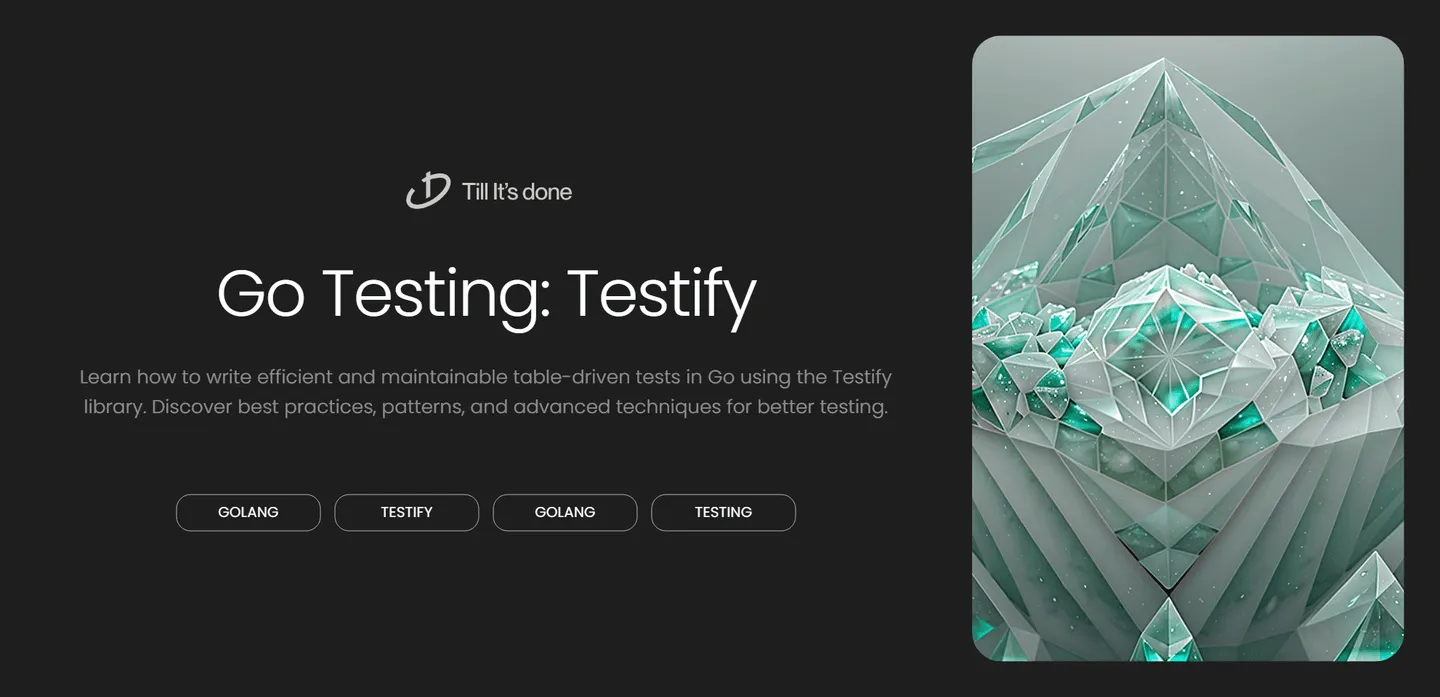- Services
- Case Studies
- Technologies
- NextJs development
- Flutter development
- NodeJs development
- ReactJs development
- About
- Contact
- Tools
- Blogs
- FAQ
Writing Table-Driven Tests Using Testify in Go
Discover best practices, patterns, and advanced techniques for better testing.

Writing Table-Driven Tests Using Testify in Golang

Table-driven tests are a powerful pattern in Go that allows you to write more maintainable and comprehensive test cases. When combined with the popular Testify library, you can create even more expressive and readable tests. Let’s dive into how to leverage this powerful combination.
Understanding Table-Driven Tests
Think of table-driven tests as a spreadsheet where each row represents a different test scenario. Instead of writing separate test functions for each case, you define a single test function that iterates through multiple test cases. This approach reduces code duplication and makes it easier to add new test cases.

Setting Up Testify
First, you’ll need to install Testify:
go get github.com/stretchr/testifyLet’s say we have a simple calculator package with an Add function that we want to test:
package calculator
func Add(a, b int) int { return a + b}Writing Table-Driven Tests with Testify
Here’s how we can write table-driven tests using Testify:
package calculator
import ( "testing" "github.com/stretchr/testify/assert")
func TestAdd(t *testing.T) { tests := []struct { name string a, b int expected int }{ {"positive_numbers", 2, 3, 5}, {"negative_numbers", -2, -3, -5}, {"zero_sum", 0, 0, 0}, {"positive_negative", -5, 5, 0}, }
for _, tt := range tests { t.Run(tt.name, func(t *testing.T) { result := Add(tt.a, tt.b) assert.Equal(t, tt.expected, result, "Add(%d, %d) should be %d", tt.a, tt.b, tt.expected) }) }}
Best Practices
-
Descriptive Test Names: Give each test case a clear, descriptive name that indicates what’s being tested.
-
Edge Cases: Include edge cases in your test table to ensure your function handles all scenarios correctly.
-
Organized Structure: Group related test cases together and use comments to separate different categories of tests.
-
Clear Failure Messages: Use Testify’s assertion messages to provide helpful debugging information when tests fail.
Advanced Techniques
You can enhance your table-driven tests with more complex scenarios:
func TestComplexCalculation(t *testing.T) { tests := []struct { name string input []int expected int shouldError bool }{ { name: "valid_input", input: []int{1, 2, 3}, expected: 6, shouldError: false, }, { name: "empty_input", input: []int{}, expected: 0, shouldError: true, }, }
for _, tt := range tests { t.Run(tt.name, func(t *testing.T) { result, err := ComplexCalculation(tt.input) if tt.shouldError { assert.Error(t, err) } else { assert.NoError(t, err) assert.Equal(t, tt.expected, result) } }) }}Conclusion
Table-driven tests with Testify provide a robust way to test your Go code. They help you write more maintainable tests, catch edge cases, and provide clear feedback when things go wrong. Start using this pattern in your projects, and you’ll see how it makes testing more enjoyable and efficient.

 สร้างเว็บไซต์ 1 เว็บ ต้องใช้งบเท่าไหร่? เจาะลึกทุกองค์ประกอบ website development cost อยากสร้างเว็บไซต์แต่ไม่มั่นใจในเรื่องของงบประมาณ อ่านสรุปเจาะลึกตั้งแต่ดีไซน์, ฟังก์ชัน และการดูแล พร้อมตัวอย่างงบจริงจาก Till it’s done ที่แผนชัด งบไม่บานปลายแน่นอน
สร้างเว็บไซต์ 1 เว็บ ต้องใช้งบเท่าไหร่? เจาะลึกทุกองค์ประกอบ website development cost อยากสร้างเว็บไซต์แต่ไม่มั่นใจในเรื่องของงบประมาณ อ่านสรุปเจาะลึกตั้งแต่ดีไซน์, ฟังก์ชัน และการดูแล พร้อมตัวอย่างงบจริงจาก Till it’s done ที่แผนชัด งบไม่บานปลายแน่นอน  Next.js สอน 14 ขั้นตอนเบื้องต้น: สร้างโปรเจกต์แรกใน 30 นาที เริ่มต้นกับ Next.js ใน 14 ขั้นตอนเพียงแค่ 30 นาที พร้อม SSR/SSG และ API Routes ด้วยตัวอย่างโค้ดง่าย ๆ อ่านต่อเพื่อสร้างโปรเจ็กต์แรกได้ทันทีที่นี่
Next.js สอน 14 ขั้นตอนเบื้องต้น: สร้างโปรเจกต์แรกใน 30 นาที เริ่มต้นกับ Next.js ใน 14 ขั้นตอนเพียงแค่ 30 นาที พร้อม SSR/SSG และ API Routes ด้วยตัวอย่างโค้ดง่าย ๆ อ่านต่อเพื่อสร้างโปรเจ็กต์แรกได้ทันทีที่นี่  วิธีสมัคร Apple Developer Account เพื่อนำแอปขึ้น App Store ทีละขั้นตอน อยากปล่อยแอปบน App Store ระดับโลก มาอ่านคู่มือสมัคร Apple Developer Account พร้อมเคล็ดลับ TestFlight และวิธีอัปโหลดที่ง่ายในบทความเดียวนี้ได้เลย
วิธีสมัคร Apple Developer Account เพื่อนำแอปขึ้น App Store ทีละขั้นตอน อยากปล่อยแอปบน App Store ระดับโลก มาอ่านคู่มือสมัคร Apple Developer Account พร้อมเคล็ดลับ TestFlight และวิธีอัปโหลดที่ง่ายในบทความเดียวนี้ได้เลย  TypeScript Interface คืออะไร? อธิบายพร้อมวิธีใช้และข้อแตกต่างจาก Type เรียนรู้วิธีใช้ TypeScript Interface เพื่อสร้างโครงสร้างข้อมูลที่ปลอดภัยและเข้าใจง่าย พร้อมเปรียบเทียบข้อดีข้อแตกต่างกับ Type ที่คุณต้องรู้ ถูกรวมเอาไว้ในบทความนี้แล้ว
TypeScript Interface คืออะไร? อธิบายพร้อมวิธีใช้และข้อแตกต่างจาก Type เรียนรู้วิธีใช้ TypeScript Interface เพื่อสร้างโครงสร้างข้อมูลที่ปลอดภัยและเข้าใจง่าย พร้อมเปรียบเทียบข้อดีข้อแตกต่างกับ Type ที่คุณต้องรู้ ถูกรวมเอาไว้ในบทความนี้แล้ว  Material-UI (MUI) คืออะไร อยากสร้าง UI สวยงามและเป็นมืออาชีพในเวลาอันรวดเร็วใช่ไหม มาทำความรู้จักกับ Material-UI (MUI) ที่ช่วยให้คุณพัฒนาแอปพลิเคชันบน React ได้ง่ายและดูดีในทุกอุปกรณ์
Material-UI (MUI) คืออะไร อยากสร้าง UI สวยงามและเป็นมืออาชีพในเวลาอันรวดเร็วใช่ไหม มาทำความรู้จักกับ Material-UI (MUI) ที่ช่วยให้คุณพัฒนาแอปพลิเคชันบน React ได้ง่ายและดูดีในทุกอุปกรณ์  เปรียบเทียบ 3 วิธีติดตั้ง install node js บน Ubuntu: NVM vs NodeSource vs Official Repo แบบไหนดีที่สุด? เรียนรู้วิธีติดตั้ง Node.js บน Ubuntu ด้วย NVM, NodeSource หรือ Official Repo เลือกวิธีที่เหมาะกับความต้องการของคุณ พร้อมเปรียบเทียบ เพื่อการพัฒนาที่มีประสิทธิภาพ!
เปรียบเทียบ 3 วิธีติดตั้ง install node js บน Ubuntu: NVM vs NodeSource vs Official Repo แบบไหนดีที่สุด? เรียนรู้วิธีติดตั้ง Node.js บน Ubuntu ด้วย NVM, NodeSource หรือ Official Repo เลือกวิธีที่เหมาะกับความต้องการของคุณ พร้อมเปรียบเทียบ เพื่อการพัฒนาที่มีประสิทธิภาพ! Talk with CEO
We'll be right here with you every step of the way.
We'll be here, prepared to commence this promising collaboration.
Whether you're curious about features, warranties, or shopping policies, we provide comprehensive answers to assist you.


